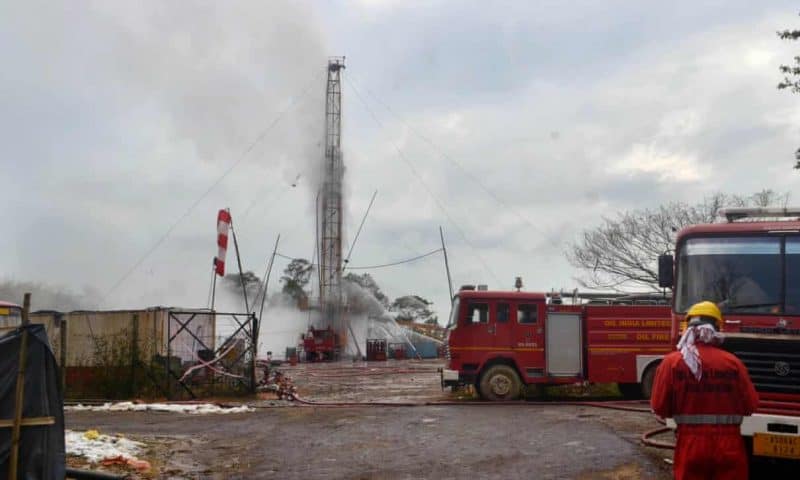About 2,500 people evacuated, amid fears that leaking oil and gas has killed river dolphins and birds
An oil well in the Indian state of Assam is still leaking gas “uncontrollably” after a blowout a week ago that it is feared has killed endangered river dolphins and birds and forced 2,500 people to evacuate their homes.
For days authorities have failed to plug the leak from the well in the village of Baghjan after the incident on 27 May. The blowout – an uncontrolled release of oil and gas due to the failure of pressure control systems – sent a fountain of crude oil into the air, “unleashing a hell”, according to local accounts.
A continuous spray of cold water is being used to cool the leaking natural gas to prevent it igniting and causing an explosion.
As the impact spread, the National Disaster Response Force was called in and about 2,500 people have been taken to relief camps.
According to Oil India Limited (OIL), which operates the well, gas was still flowing uncontrollably from the leak on Tuesday. The company has called in foreign experts in an attempt to get the leak under control, but locals and environmental activists say that untold damage has already been done to the rare biodiversity of the area, as well as to essential local agriculture.
Baghjan village, where the rig is located, sits next to the protected Dibru Saikhowa national park and Maguri Beel wetlands, which is home to dozens of species of migratory birds, rare wildlife and aquatic species. However, the rivers running into the wetlands are said to have become contaminated from the explosion, with the residue from the oil spill sitting on the surface of the water, leading to the poisoning and suffocation of aquatic species.
At least one critically endangered Gangetic river dolphin has been found dead in the nearby river, its outer skin scaly and peeling, and locals fear there are other carcasses in less accessible locations. Several endangered birds and fish have also been found dead, and a sticky layer of oil has formed on the leaves of the trees in the national park.
“The company [OIL] has failed in every aspect,” said Niranta Gohain, an environmental activist from the area. Gohain accused the company of safety lapses and said the blowout had “erased a humbly balanced rural economy”.
There has also been a high human cost. Locals have complained of headaches, burning eyes and nasal passages and respiratory problems since the rig blowout. Many families in the surrounding area also rely on fishing in the rivers, now feared contaminated, for their food and livelihoods, and livestock such as chickens have already been found dead.
The Baghjan gas leak is the latest in a series of industrial disasters in India. Less than a month ago a factory in Andhra Pradesh state exploded, leaking toxic gas into the air and killing 12 people. India’s top environmental court this week blamed “gross human failure” and lack of basic safety norms for the incident.
Environmentalists said the oil rig explosion also exposed the environmental risk posed by allowing rigs to operate so close to protected areas of biodiversity. Just last month, OIL were given permission to drill in seven locations in Dibru Saikhowa national park.
Following an inspection of the blowout site on Sunday, OIL’s chairman and managing director Sushil Chandra Mishra told reporters: “Our focus is on providing relief to the people affected by the accident at the time of Covid-19 while trying to bring the operations back to normal.”
A statement from OIL said the company was “awaiting the observations and findings of the district administration, forest department, pollution control board so that all necessary steps can be taken”.

